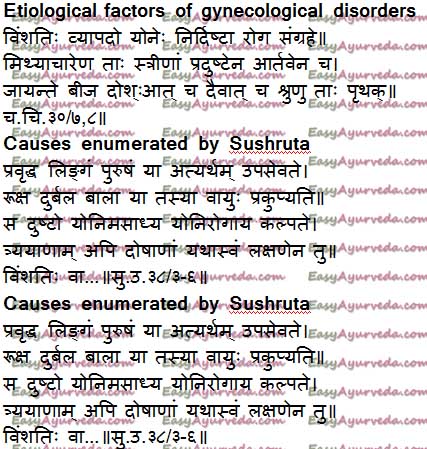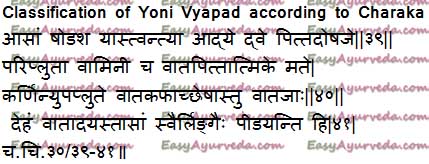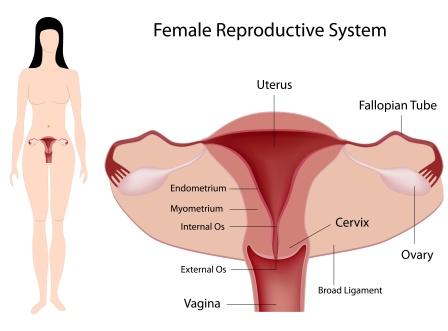Gynecological Disorders Causes, Types As Per Ayurveda
By Dr Raghuram Y.S. MD (Ay) & Dr Manasa, B.A.M.S
Yoni Vyapad are the group of gynecological disorders explained in Ayurvedic texts. These comprises diseases of female reproductive system.
Table of Contents
Introduction
Yoni Vyapad means ‘diseases of female genital system. The term Yoni is used to indicate female reproductive system, in broader sense.
Some of menstrual disorders like menorrhagia etc are explained separately and have not been included under yoni vyapad. But in order to get a precise knowledge menstrual disorders, one should have a precise and comprehensive knowledge of Yoni Vyapad.
Read – Perimenopause Symptoms, Ayurvedic Treatment, Lifestyle Tips
Sanskrit verse


Causes
Causes for gynecological disorders:
Charaka mentions four main causative factors as responsible for 20 gynecological disorders.
Wrong diets
1. Mithyachara – Wrong food and diet habits
This factor includes –
– Mithya ahara i.e. abnormal diet
– Mithya vihara i.e. abnormal mode lifestyle
Various environmental factors operating either during embryonic life of the girl i.e. congenital abnormalities or at a later part of life are also included under this heading.
Read – 11 Ayurvedic eating tips for good health
a. Abnormal diet –
Excessive intake of food – which might cause obesity, over nutrition, indigestion, metabolic disorders like diabetes etc and cause many gynecological disorders
Inadequate intake of food – may cause nutritional deficiency and related symptoms like weakness and emaciation leading to gynecological diseases like arajaska or lohitakshaya etc
Consumption of unwholesome foods
Consumption of unhygienic foods
Consumption of incompatible foods and food combinations
All the above said dietetic abnormalities will affect and vitiate doshas and tissues of the body which consequentially would cause wide array of gynecological disorders
Read related: Diet And Lifestyle For Women In Ayurveda

Unhealthy lifestyle
b. Abnormal lifestyle:
Abnormal body position and postures during sex.
Use of artificial organs as vaginal stimulant
The above mentioned factors may cause local ulceration in the genital organs, hyperemia and infection. These will in turn cause various gynecological disorders. The same factors would also reflect abnormal psychology of an individual. These psychosomatic abnormalities are the etiological factors of gynecological disorders.
Read – Ritucharya – Healthy Seasonal Regimen – Introduction, Divisions
Menstrual pathology
2. Pradushta Artava – abnormalities of menstrual blood or ovum
Contamination of arthava is also a main cause of gynecological disorders. The word artava refers to ovarian hormones, ovum and menstrual blood.
Ovum as such cannot produce diseases since it is shed once in a month.
The menstrual blood is a result of endometrial changes occurring in the uterus brought about by the action of hormones and reflects the status of female reproductive organs and also the hormones.
The menstrual blood causes diseases when it is contaminated by the doshas and these diseases are called as artava dushti – diseases of contaminated menstrual blood. These conditions cannot be included in this.
The left out inclusion is the hormones. In this context, artava pradushti points towards the abnormalities of ovarian hormones. When these hormones are imbalanced, they can cause gynecological disorders.
Read – Stress Symptoms and Natural Measures for Stress Relief
Sperm, ovum defects
3. Bija Dosha – abnormalities of sperms or ovum
Abnormalities of the sperms or ovum can cause many gynecological disorders. Various kinds of chromosomal abnormalities and genetic abnormalities can be included in this group.
Idiopathic
4. Daiva – Godly or divine factors
Unknown etiological factors come under this category. This includes factors like misdeeds done in the previous birth etc. When the causative factors of any disease cannot be tracked down, it is said that they are caused due to such divine, unseen and unpredictable causes.
Read Bleeding During Pregnancy: Causes, Ayurvedic Treatment
As per Sushrutha
Causes enumerated by Sushruta
When a woman having dryness of the body or a woman who is weak or girl who is very young have excessive coitus with a man having big size penis, the vata Dosha gets aggravated in her body. This vitiated vata aggravates pitta and kapha or withholds pitta and kapha which have already been vitiated due to their specific causes. Vata, along with pitta and kapha reaches the yoni i.e. vagina or female reproductive organs and produces various kinds of disorders. All these three doshas will produce symptoms in the yoni depending on their predominance and cause 20 types of yoni vyapads. This happens due to consumption of abnormal foods and life activities, contamination of menstrual blood, ovum and hormones, contamination of sperms or ovum and due to divine effect, effect of misdeeds done in past or idiopathic causes.
Read – Effective Obesity Treatment, Remedies And Ayurveda Tips
As per Vaghbhata
Causes mentioned by Vagbhata
References from both Ashtanga Hridaya and Ashtanga Sangraha enlist the below mentioned etiological causes for yoni vyapad –
– Dushta bhojana – abnormal diet
– Vishamastha anga shayana – sleeping by keeping body parts in abnormal postures
– Vishamastha anga shayana maithunam – having coitus in abnormal postures of the body
– Bhrisha maithuna sevana – getting indulged in excessive coitus
– Dushta artava – abnormalities menstrual blood, ovum or hormones
– Dushta bija – abnormalities of portion of ovum responsible for development of yoni during embryonic life
– Apadravya upayoga – use of artificial sexual toys made up of iron etc for sexual pleasure
– Daiva – cursing from god, effect of misdeeds done in the past birth.
Read – Mental And Spiritual Benefits Of Fasting
Other opinions
Kashyapa says that if nasal medication is given to women just after their menstrual period is over, she suffers from yoni shosha i.e. dryness of vagina and genital organs.
In Madhava Nidana, Bhavaprakasha and Yogaratnakara we can find similar explanation on the lines of Charaka.
Read Polycystic ovarian syndrome: Ayurvedic Treatment, Remedies, Diet
Master Bhela has explained diseases of sacral region, vagina and uterus among the diseases developing in a particular part of the body i.e. ekanga vata, due to the vitiation of vata. Thus vata vitiation should be taken as an important cause for the manifestation of diseases of vagina and uterus.
Classification
Number of gynecological disorders as per Ayurveda:
Gynecological disorders are 20 in number.
Classification is done on the basis of predominant dosha.
Classification of Yoni Vyapad according to Charaka
They can be classified into 2 main categories.
Based on dosha
Doshaja Yoni Vyapad – Types of gynecological disorders caused due to involvement of vitiated doshas are of four types.
– Vatiki Yoni Vyapad – caused due to vitiation of vata
– Paittiki Yoni Vyapad – due to vitiation of pitta
– Shlaishmiki Yoni Vyapad – due to vitiation of kapha
– Sannipatiki – caused due to simultaneous vitiation of all three doshas
Read – Lifestyle Tips For Healthy People And Patients In Ayurveda
Dosha Dushya Sammurchana Janya Yoni Vyapad – types of gynecological disorders caused due to vicious amalgamation of vitiated doshas and tissues followed by subsequent tissue damage are sixteen in number.
– Raktayoni – caused due to vitiation pitta
– Arajaska – caused due to vitiation pitta
– Acharana – caused due to vitiation of vata
– Aticharana– caused due to vitiation of vata
– Prakcharana– caused due to vitiation of vata
– Upapluta – caused due to dual vitiation of vata and kapha
– Paripluta – caused due to dual vitiation of vata and pitta
– Udavartini– caused due to vitiation of vata
– Karnini – caused due to dual vitiation of vata and kapha
– Putraghni– caused due to vitiation of vata
– Antarmukhi– caused due to vitiation of vata
– Soochimukhi– caused due to vitiation of vata
– Shushka– caused due to vitiation of vata
– Vaamini – caused due to dual vitiation of vata and pitta
– Shandhayoni – caused due to vitiation of vata
– Mahayoni – caused due to vitiation of vata
Read – Vaginal White Discharge (Leucorrhea) Ayurvedic Treatment, Home Remedies
Charaka
Thus, according to Charaka:
11 types of gynaecological disorders are caused due to vitiated vata – Vatiki, acharana, aticharana, prakcharana, udavartini, putraghni, antarmukhi, suchimukhi, sushka, shandayoni and mahayoni
3 types of yoni vyapads are caused due to vitiated pitta – paittkik, raktayoni and arajaska
1 type of yoni vyapad is caused by vitiated kapha – shlaishmiki
1 type of yoni vyapad is caused by vitiated tridoshas – sannipatiki
2 types of yoni vyapads are caused by dual vitiation of vata and pitta – paripluta and vamini
2 types of yoni vyapads are caused by dual vitiation of vata and kapha – upapluta and karnini
Sushrutha
Classification of Yoni Vyapad according to Sushruta
Sushruta has classified five conditions due to vitiation of each dosha and five due to simultaneous vitiation of all doshas.
Gynecological disorders caused by vitiated vata
– Udavarta
– Vandhya
– Vipluta
– Paripluta
– Vatala
Read – Pelvic Inflammatory Disease: Ayurvedic Treatment, Therapies, Medicines
Gynecological disorders caused by vitiated pitta
– Rudhirakshara
– Vamini
– Sramsini
– Putraghni
– Pittala
Read – 4 Ayurvedic Herbal Home Remedies For Heavy Periods
Gynecological disorders caused by vitiated kapha
– Atyananda
– Karnini
– Acharana
– Aticharana
– Shleshmala
Gynecological disorders caused by simultaneous vitiation of all three doshas
– Shanda
– Phalini
– Mahati
– Suchivaktra
– Sarvaja
Read – Heavy Periods, Menstrual bleeding Ayurvedic Treatment
Vagbhata
Classification of Yoni Vyapad according to Vagbhata
Vatiki Yoni Vyapad – caused by vitiated vata
– Vatiki
– Aticharana
– Prakcharana
– Udavrtta
– Jataghni (putraghni by charaka)
– Antarmukhi
– Suchimukhi
– Shushka
– Vamini
– Sandi (shandayoni by Charaka)
– Mahayoni
Paittiki Yoni Vyapad – caused by vitiated pitta
– Paittiki
– Raktayoni
Shlaishmiki Yoni Vyapad – caused by vitiated kapha
– Shlaishmiki
Sannipatiki Yoni Vyapad – caused by simultaneous vitiation of tridoshas
– Sannipatiki
Read –Somaroga – Excessive Female Discharge With Loss Of Vitality
Vata-Pittaja Yoni Vyapad – caused by simultaneous vitiation of two doshas i.e. vata and pitta
– Lohitakshaya
– Paripluta
Vata-Kaphaja Yoni Vyapad – caused by simultaneous vitiation of two doshas i.e. vata and kapha
– Upaplata
– Karnini
Krimija – caused by microbes, worms
– Vipluta
Read –Comparative Study Of PID With Yoni Vyapath
Sharangadhara
Classification of Yoni Vyapad according to Sharangadhara
– Vataja
– Pittaja
– Kaphaja
– Sannipataja
– Raktaja
– Lohitakshayaja
– Sushka
– Vamini
– Khandita (udavrtta by Vagbhata)
– Antarmukhi
– Suchimukhi
– Vipluta
– Jataghni
– Paripluta
– Upapluta
– Prakcharana
– Mahayoni
– Karnini
– Nanda (Shanda by Vagbhata)
– Aticharana
Read – Banana flower Sabji For Pitta Balance, Stomach Pain, Worms [Video]
Other authors
Classification of Yoni Vyapad according to other authors
Kashyapa has mentioned number of gynecological disorders but has not described anything further, though scattered references resembling many conditions are available.
Bhavaprakasha’s classification resembles that of Sushruta. In this we find mention of anandacharana or charana in place of acharana and andini in place of phalini yoni vyapad.
Madhava Nidana also gives explanation of yoni vyapads on lines of Sushruta. We can find mention of lohitakshaya in place of lohitakshara or rudhira kshara.
In Yogaratnakara, the classification is identical to Madhava Nidana.
Opinion comparison
Difference Of Opinion In Classification Of Yoni Vyapad:
All authors have classified yoni vyapad into 20 types. But there is difference in opinion about placement of one or more of those types in particular categories by different authors i.e. in different classics.
Read –Comparative Study Of PID With Yoni Vyapath
Explanation for difference of opinion in classification of yoni vyapad by various authors
Almost all classics have mentioned 20 types of gynecological disorders. But when we see through depth of classification by various authors, we could find difference of opinion regarding causative doshas in some types of yoni vyapads.
Charaka has described 11 conditions caused by Vata, three due to vitiated pitta, one each due to kapha and tridosha vitiation, 2 conditions due to vata pitta and 2 due to vata kapha vitiation.
Sushruta has described 5 conditions as caused by each dosha and 5 due to simultaneous vitiation of 3 doshas.
Vagbhata has almost followed Charaka’s description.
All other authors have followed either of these 3 classifications of Charaka, Sushruta or Vagbhata.
Read – Rectal Prolapse – Causes, Treatment, Useful Herbs
Bhavaprakasha’s classification is similar to that of Sushruta.
In Bhavaprakasha we find anandacharana or charana mentioned in place of acharana and andini in place of phalini yoni vyapad.
Madhava Nidana also classifies gynecological disorders similar to that of Sushruta.
Madhava Nidana mentions lohitakshaya in place of lohitakshara or rudhirakshara.
In Yogaratnakara, classification is similar to Madhava Nidana.
Kashyapa has mentioned number of yoni vyapad but has not given their description.
Scattered references resembling many conditions of yoni vyapads are available.
Read – Polycystic ovarian syndrome: Ayurvedic Treatment, Remedies, Diet
Analysis
Analysis of difference of opinion regarding classification of Yoni Vyapad
Conditions with identical names but classified under different doshic categories –
It becomes difficult to explain difference of opinion regarding causative doshas of conditions like shanda, mahati or mahayoni, suchivaktra or suchimukhi which have identical names as well as clinical features.
Example, Shandayoni or Shandi is caused by vitiated Vata according to Charaka and Vagbhata whereas Sushruta calls it as caused by simultaneous vitiation of all three doshas.
Similarly Suchimukhi is caused by vata according to Charaka and Vagbhata whereas it is caused by tridosha according to Sushruta.
But a hypothesis could be drawn. There is a possibility that Charaka and Vagbhata has mentioned chief dominating dosha i.e. vata as causative factor.
At same time Sushruta would have taken other associated symptoms caused by associated doshas and also prognosis of Shanda or Suchimukha while naming them as tridoshaja.
Read – Importance Of Diet (Pathya) For Specific Diseases
Conditions which resemble each other but have been given different names and different causes in terms of doshas involved –
Charaka and Vagbhata have given different etiological factors for acharana / vipluta, arajaska / lohitakshaya and vamini.
Acharana is caused by vata according to Charaka whereas a condition resembling Acharana has been named as Vipluta by Vagbhata and has explained it to be caused by microbes or parasites. Similarly, arajaska is caused by vitiated pitta according to Charaka while a similar condition is named as Lohitakshaya by Vagbhata and has been said to be caused by vitiated combination of vata and pitta.
Likewise, Vamini is a condition caused by vitiated combo of vata and pitta according to Charaka but it is caused by only vitiated Vata according to Vagbhata.
In both explanations of vamini, chief complaint is expulsion of semen from uterus or vagina, 5-6 days after its entry into female genital system.
Read – Complete Guide to Fungal Infections, Its Types And Preventions
Conditions whose treatments have been elaborated but have not been included in 20 types of yoni vyapad –
Coming to numbers, all Ayurvedic teachers have mentioned 20 Yoni Vyapads.
On contrary, Charaka and Vagbhata have explained treatments for conditions named Srasta and Prasrasta (uterine or vaginal displacements / prolapsed) whereas these conditions have not been included in list of 20 disorders.
Treatment of symptoms like roughness, stiffness, loss of sensation, protuberant upwards, upwards displacement, dilated vagina or uterus etc. but they have not been included in list of Yoni Vyapad.
In fact they cannot be considered as separate disease entities. These symptoms are seen in 20 gynecological disorders.
Explanation of treatment for these conditions point out towards focus on treating worst presenting or complaints.
Read –Touch Me Not Plant: Uses, Side Effects, Research
While explaining treatment for roughness etc Ayurvedic teachers were explaining treatment of predominant symptoms found in different Yoni Vyapads. This would help the physician to at least treat worst complaints if diagnosis of condition has not been made.
Prasrams or Sramsa are symptoms of Mahayoni, therefore they cannot be considered as individual diseases. Treatment of Prasramsa or Sramsa focuses on treating displacement of organs occurring in Mahayoni, this is itself treatment for Mahayoni.
On other hand, Sushruta has mentioned a separate disease entity named Sramsini yoni vyapad and has counted it as one among 20. According to Sushruta, it is caused by vitiated Pitta.
Similarly uttana which explains retroversion of uterus and unnata which explains anteflexion of uterus are also different presentations of uterine displacements.
Conditions not explained but treatment available –
Charaka has not explained clinical features of vipluta but has prescribed treatment for same.
Read – KsharaSutra Treatment: Introduction, Indication, Contra Indications
Summary
Summary of difference in opinion in numbering the yoni vyapads
Thus it appears that number twenty is given only to denote plurality of conditions and not the exact number of gynecological disorders.
Authors would have highlighted diseases prevalent during their time.
They would have included and explained main available conditions among 20.
They would have explained other conditions as symptoms and would have advised treatment for same.
They would have preferred not to cross number given by their teachers or their predecessor acharyas and have maintained numbers.
Among twenty, they have mentioned conditions available predominantly during their period and would have included conditions explained by their previous teachers in category of miscellaneous since they were less predominantly seen in their era, with evolution of disease and diseased.
There may be a chance that new conditions appeared with evolution and few mentioned earlier would have disappeared due to availability of better treatment conditions.
Read – Raktapitta Pathya: Ideal Foods To Take In Bleeding Disorders
There is a possibility the method of examination of the disease and diseased, the perspective of looking at same condition, analysis of causative factors, doshas involved and short listing of pathogenesis of same condition changed from generation to generation.
Click to Consult Dr Raghuram Y.S. MD (Ayu) – Email / Skype








2 comments
Khalid Lakdawala
Is PCOD curable in Ayurveda?
Dr J V Hebbar MD(Ayu)Author
I cannot guarantee.
Please consult an Ayurveda doctor directly.